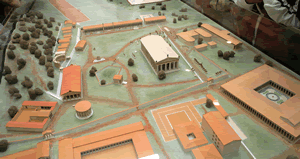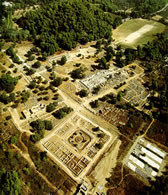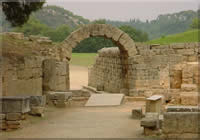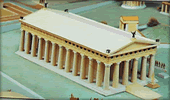Ancient olympia archeological site


The situation of the sanctuary of olympia in a lush region irrigated by two rivers, the Alpheus and the Cladeus, led Pindar to call it the kallistos topos (most beautiful place) of Greece.
The sacred grove of Zeus, or Altis as the ancients called it, was filled with plane trees and wild olives that were dedicated to Zeus the fother of all gods and mortals.
Approaching the archeological site before you reach the museum parking area you will cross a bridge over the Cladeus river. The riverbed remains dry for most of the year now but in ancient times it was one of Olympiads vital rivers. You enter the sanctuary on the north side and proceed along the lenght of the Gymnasium which has not yet been uncovered in its entirety. The hill of Cronus at whose foot lay the sacred precinct, bound the site on the north. Outside the sacred precinct were the athletic facilities and visitors accommodations (guest houses baths etc).
The southeast section of the site that contained the Hippodrome has been washed away by the waters of the Alpheus river. Excavations began at olympia in the 19th century, but continue to this day.

Important finds included sculptures from the Temple of Zeus, the Nike of Paeonius, the Hermes of Praxiteles and many bronzes. In total 14,000 objects were recorded. The finds were displayed in a museum on the site.
1900-1950 Excavation was continued in a more limited way by Dorpfeld between 1908 and 1929 but a new systematic excavation was begun in 1936 on the occasion of the 1936 Summer in Berlin under Emil Kunze and Hans Schleif . Their excavation focus on the area to the south of the stadium, the South stoa, bath complex and gymnasion.
1950 to present Between 1952 and 1966, Kunze and Schleif continued the excavation joined by architect Alfred Mallwitz. They excavated Pheidias' workshop, the Leonidaion and the north wall of the stadium. They also excavated the southeast section of the sanctuary and out of approximately 140 debris pits found many bronze and ceramic objects along with terracotta roof tiles.
Mallwitz took charge of the excavations between 1972 and 1984 revealing important dating evidence for the stadium, graves, and the location of the Prytaneion. From 1984 to 1996, Helmut Kyrieleis took over the site and the focus shifted to the earlier history of the sanctuary with excavation of the Prytaneion and Pelopion.
Archeological site
The first major excavation of Olympia began in 1875, funded by the German government after negotiation of exclusive access by Ernst Curtius. Other archaeologists responsible for the dig were Gustav Hirschfeld, George Treutitle, and Adolf Furtwangler who worked alongside architects A. Boetticher, Wilhelm Dorpfeld, and Richard Borrmann. They excavated the central part of the sanctuary including the Temple of Zeus, Temple of Hera, Metroon, Bouleuterion, Philipeion,Palaestra etc.






















